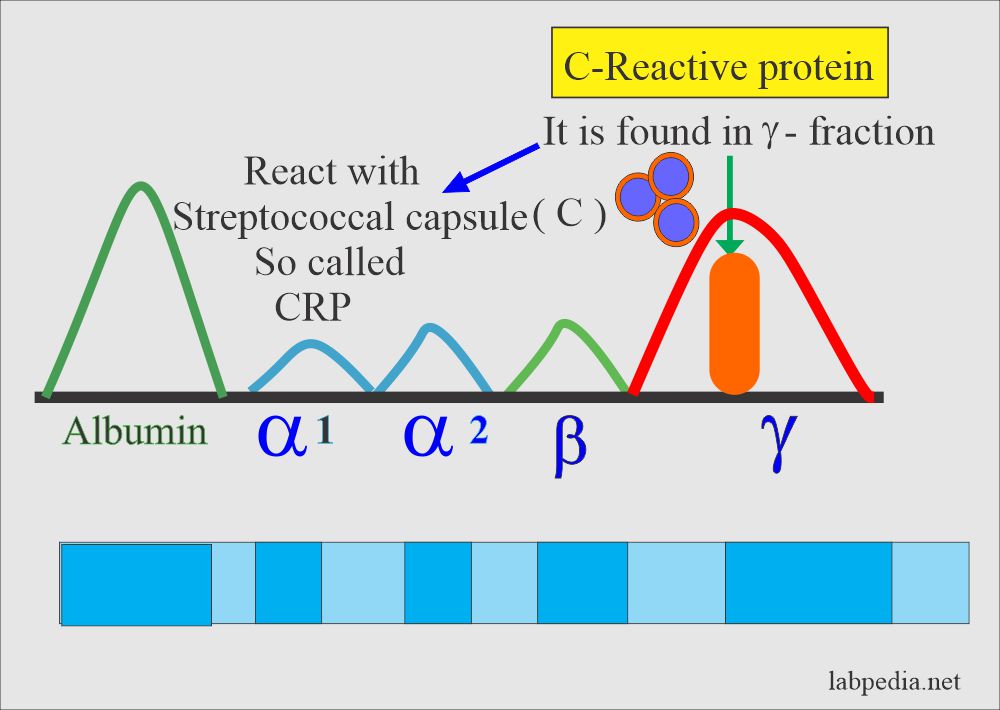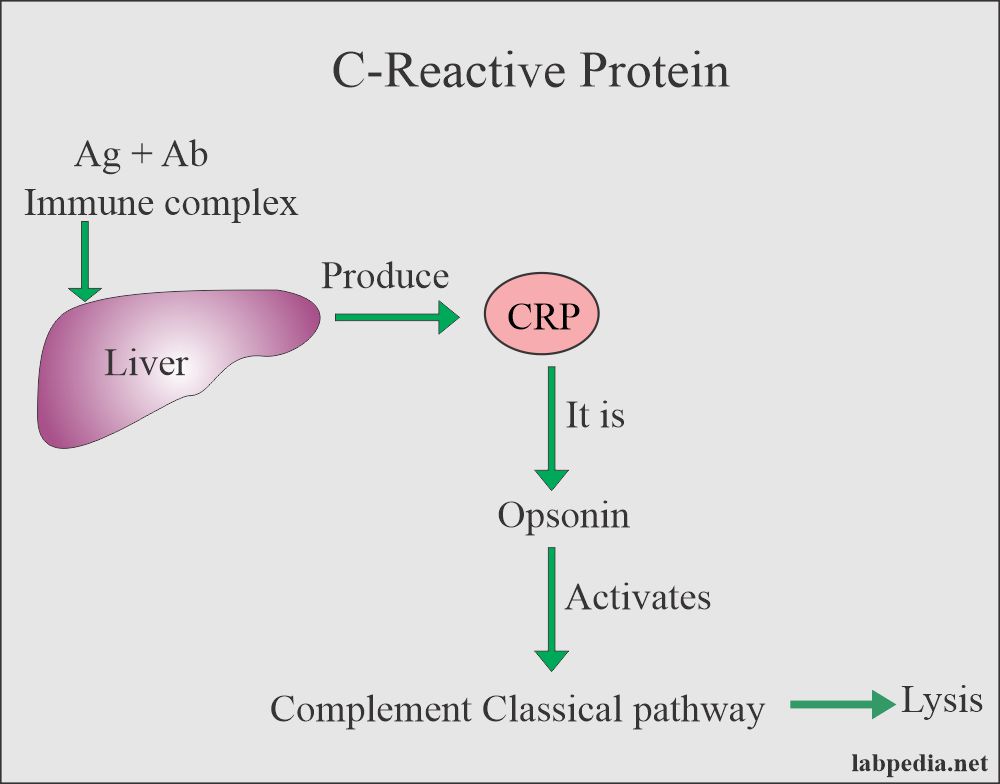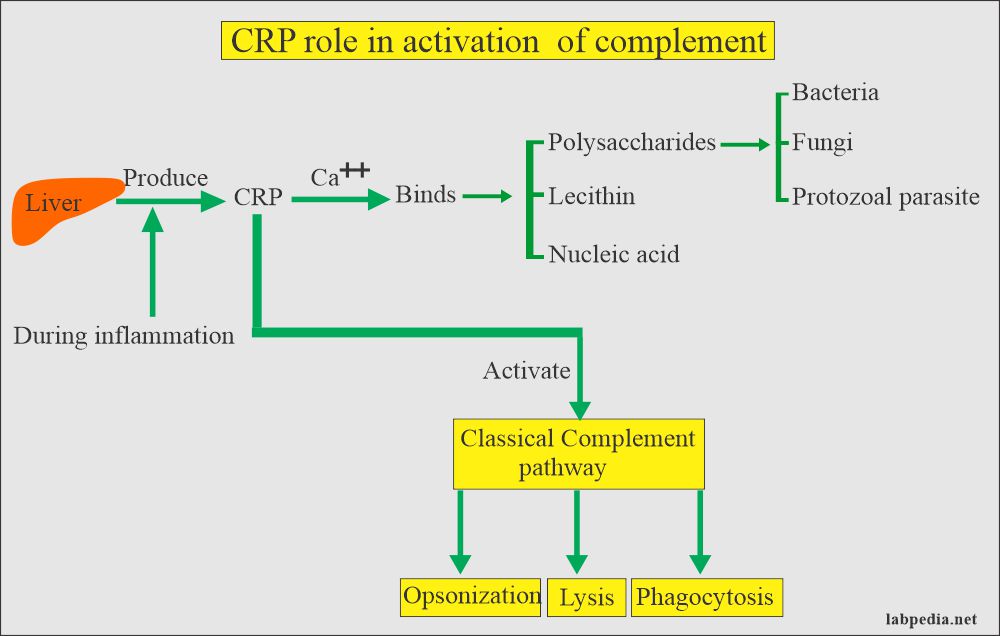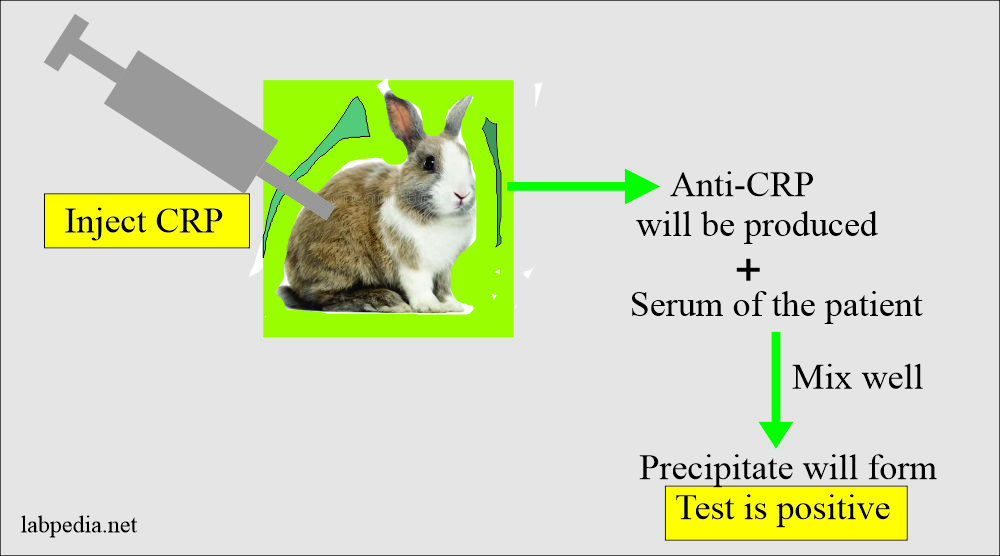C-reactive protein (CRP)
Definition
1. CRP is γ-globulin (in the γ-region); is found in various inflammatory diseases. This is also called acute-phase protein.
2. CRP is produced in the liver.
3. CRP name is derived from the reaction with streptococcal capsular (C) polysaccharide.
 C-Reactive Protein (CRP)
C-Reactive Protein (CRP)CLINICAL SIGNIFICANCE: C-reactive protein is an acute phase protein present in normal serum, which increases significantly after most forms of tissue injuries, bacterial and virus infections, inflammation, and malignant neoplasia. CRP contributes to non-specific defense by complement activation and accelerating phagocytosis. CRP testing has a high diagnostic value on a tentative diagnosis made on the basis of case history and clinical findings.
Principle:
1. CRP is opsonin and it activates the complement system and ultimately leads to lysis.
2. Serum of the patient (CRP) + Somatic C polysaccharide of pneumococci mixed and gives rise to a precipitate.
3. Practically CRP is injected into the rabbit when the anti-CRP antibody is produced. Now take serum of the patient (CRP) + Mix anti-CRP. This will give precipitation.
CRP + Anti CRP = Precipitation
Causes of CRP
1. Produced in various bacterial diseases.
2. Produced by injured myocardial muscle in myocardial infarction.
3. Positive in acute and chronic rheumatic fever.
CRP is also positive in:
1. Sydenham's Chorea.
2. Myocardial infarction and negative in angina.
3. Many malignancies.
4. Rheumatoid arthritis.
5. Gout.
6. Viral infection like Viral Hepatitis.
7. Bacterial Pneumonia.
8. Active Tuberculosis.
9. Lepromatous Leprosy.
10. Acute Tonsillitis, Scarlet fever, and Mumps.
PRINCIPLE: CRP-Latex Test is a rapid slide agglutination procedure, developed for the direct detection and semi-quantitation of C-reactive protein (CRP) in serum. The assay is performed by testing a suspension of latex particles coated with anti-human CRP antibodies against unknown serum. The presence of a visible agglutination indicates an increase of the CRP level above the upper limit of the reference interval in the samples tested.
REAGENT COMPOSITION - CRP-Latex Reagent: Suspension of polystyrene latex particles coated with specific anti-human C-reactive protein antibodies in a buffered saline solution. CONTROL + Human serum with a CRP concentration > 15 mg/L. CONTROL - Animal serum with a maximum concentration of human CRP of 1 mg/L. Precautions: Components of different human origin have been tested and found to be negative for the presence of antibodies anti-HIV 1+2 and anti-HCV, as well as for HBsAg. However, the controls should be handled cautiously as potentially infectious.
EXPECTED VALUES: While the C-reactive protein concentration is generally below 5 mg/L in the sera of healthy adults, in a number of disease states these values often exceeded within 4 to 8 hours after an acute event and reach levels up to 500 mg/L. Since an elevated CRP level is always associated with pathological changes, determination of CRP is of great value in diagnosis, treatment and monitoring of inflammatory conditions.
ANALYTICAL PERFORMANCE The minimum detectable unit (analytical sensitivity) is of approximately 6 mg/L (5-10 mg/L). Hemoglobin (<10 g/L), bilirubin (<20 mg/dL) and lipemia (<10 g/L) do not interfere. Rheumatoid factors (>100 IU/mL) interfere. Other substances may interfere.
LIMITATIONS OF PROCEDURE The presence of rheumatoid factors (RF) in a serum sample may cause false positive reactions. The sensitivity of the test may be reduced at low temperatures. The best results are achieved at 15-25ºC. Delays in reading the results may result in over-estimation of the CRP concentration. In case of positivity, use the titration/dilution procedure, as presented above, at the "ASLO/CRP/RF" section.




No comments:
Post a Comment